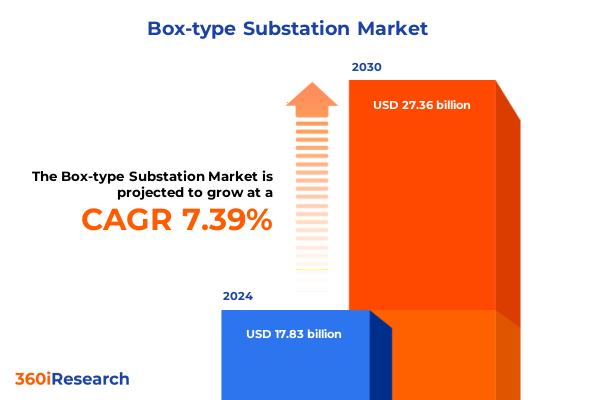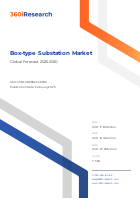The Box-type Substation Market size was estimated at USD 17.83 billion in 2024 and expected to reach USD 19.16 billion in 2025, at a CAGR 7.39% to reach USD 27.36 billion by 2030.

Introduction to the Evolving Box-Type Substation Landscape
In recent years, the box-type substation market has emerged as a cornerstone of modern electrical infrastructure, driven by accelerating urbanization, the proliferation of renewable energy sources, and an imperative for grid modernization. These compact, prefabricated units integrate equipment such as transformers, circuit breakers, and protective devices within modular enclosures, offering rapid deployment and streamlined installation in space-constrained environments. The adoption of box-type substations has been further propelled by stringent safety standards and the demand for reduced on-site construction time, enabling utilities and industrial operators to optimize capital expenditures while maintaining high reliability.
Moreover, the global push toward decarbonization and electrification of transportation networks underscores the critical role of box-type substations in supporting distributed energy resources and smart grid initiatives. By facilitating seamless integration of photovoltaic arrays, wind farms, and energy storage systems, these substations enhance grid flexibility and resilience. Consequently, stakeholders across energy, industrial, and public infrastructure sectors are increasingly prioritizing box-type solutions to address evolving power distribution challenges and ensure scalable, future-proof networks.
Transformative Shifts Reshaping Box-Type Substation Markets
The box-type substation landscape is undergoing transformative shifts, fueled by digitalization, regulatory changes, and heightened sustainability expectations. Digital transformation is enabling real-time monitoring and predictive maintenance, with embedded sensors and IoT platforms providing granular insights into equipment health and load dynamics. As a result, operators can reduce unplanned outages and extend asset lifecycles, unlocking substantial operational savings.
Simultaneously, sustainability mandates are accelerating the adoption of eco-efficient designs that minimize environmental impact. Manufacturers are incorporating advanced insulation technologies and low-global-warming-potential gas mixtures in gas-insulated configurations, while prefabricated air-insulated modules are optimized for recyclability. Furthermore, the rise of renewable energy integration is spurring demand for modular substation solutions that can be rapidly scaled to accommodate fluctuating generation profiles.
In addition, geopolitical shifts and supply chain volatility have underscored the importance of resilient sourcing strategies. Localized manufacturing hubs and strategic inventory management are now integral to mitigating disruptions. Consequently, stakeholders are reimagining their value chains to balance cost, agility, and compliance, ushering in a new era of innovation and collaboration across the box-type substation ecosystem.
Assessing the Cumulative Impact of United States Tariffs in 2025
The implementation of enhanced United States tariffs in 2025 has exerted a cumulative impact on box-type substation supply chains, influencing material costs, procurement strategies, and competitive dynamics. Steel and specialized electrical components have borne the brunt of increased duties, prompting manufacturers to reassess source markets and explore alternative alloys and composite materials. Consequently, design teams are prioritizing weight reduction and material efficiency to offset tariff-induced cost pressures without compromising performance or safety.
Moreover, equipment assemblers have accelerated localization efforts, expanding domestic production capacities to mitigate import dependencies. This shift has fostered strategic partnerships between utilities and regional fabricators, streamlining certification processes and reducing lead times. From a market perspective, the tariffs have also catalyzed innovation in component standardization and modular interchangeability, as suppliers refine product portfolios to deliver cost-effective, tariff-resilient offerings.
In parallel, end users are adopting proactive procurement frameworks that incorporate total cost of ownership analyses and scenario-based risk assessments. By integrating dynamic pricing models and flexible contract terms, project developers can navigate tariff fluctuations with greater certainty. Ultimately, the 2025 tariff landscape is redefining competitive positioning, incentivizing supply chain diversification and reinforcing the value of agile, responsive business models.
Key Segmentation Insights for Box-Type Substation Markets
A close examination of market segmentation reveals nuanced demands across product types, components, applications, installation types, and end users. In terms of product type, air-insulated substations dominate sectors requiring cost-effective, medium-voltage distribution, with high-voltage configurations employing double bus, ring bus, and single bus layouts to cater to varied network topologies. Conversely, gas-insulated substations capture high-density urban and harsh-environment projects, offering voltage classes of 110kV, 220kV, and 380kV that emphasize compact footprints and enhanced safety.
Component segmentation underscores the critical role of circuit breakers-spanning air, gas, and vacuum technologies-in ensuring reliable fault interruption, while protective devices such as relays and surge arresters safeguard system integrity. Transformers, bifurcated into distribution and power classes, address distinct load profiles; dry-type units are favored in indoor installations for fire safety, whereas oil-immersed variants deliver high efficiency in heavy-industrial contexts.
Application-wise, commercial buildings-from office towers to retail centers-prioritize turnkey substation packages that expedite commissioning, while industrial clients in chemical processing, manufacturing, and oil & gas demand robust designs resilient to extreme conditions. Public infrastructure deployments in transportation and utilities further accentuate the need for modularity and rapid deployment.
Installation types split between indoor and outdoor environments, with outdoor stations differentiated by the presence or absence of perimeter fencing to meet site security and access requirements. Finally, end users in defence and military installations require ruggedized, low-signature solutions, transport and logistics operators focus on port and railroad electrification, and utilities leverage substation assets for decentralized power generation projects.
This comprehensive research report categorizes the Box-type Substation market into clearly defined segments, providing a detailed analysis of emerging trends and precise revenue forecasts to support strategic decision-making.
- Product Type
- Component
- Application
- Installation Type
- End-User
Regional Dynamics Driving Box-Type Substation Adoption
Regional dynamics play a pivotal role in shaping box-type substation adoption. In the Americas, grid modernization initiatives in the United States and Canada, coupled with renewable integration projects across Latin America, are driving demand for prefabricated substations that minimize site disruption and expedite electrification. Conversely, in Europe, Middle East & Africa, stringent regulatory frameworks and ambitious decarbonization targets are stimulating investments in both air- and gas-insulated technologies, with a particular emphasis on smart grid interoperability and carbon-neutral designs. Meanwhile, Asia-Pacific remains a hotspot for rapid urban expansion and industrialization. China’s expansive transmission network upgrades, India’s rural electrification programs, and Southeast Asia’s burgeoning manufacturing hubs collectively underscore the region’s appetite for scalable, cost-effective substation solutions that can support diverse load growth trajectories.
This comprehensive research report examines key regions that drive the evolution of the Box-type Substation market, offering deep insights into regional trends, growth factors, and industry developments that are influencing market performance.
- Americas
- Asia-Pacific
- Europe, Middle East & Africa
Competitive Landscape: Leading Companies in Box-Type Substations
The competitive landscape is characterized by a blend of global powerhouses and specialized innovators. ABB Ltd. and Siemens AG continue to lead on technology integration and digital services, while General Electric Company and Schneider Electric SE differentiate through comprehensive lifecycle support and aftermarket services. Mitsubishi Electric Corporation, Hitachi, Ltd., and Toshiba Corporation leverage deep R&D capabilities to introduce next-generation insulation and automation features. Meanwhile, firms such as CG Power and Industrial Solutions Limited, Nari Group Corporation, and TBEA Co., Ltd. are expanding their footprints in emerging markets through localized manufacturing and tailored financing solutions.
Eaton Corporation plc and Hyosung Heavy Industries Corporation focus on modular component design, enhancing system interoperability and ease of maintenance. Lucy Electric and Meidensha Corporation specialize in medium-voltage prefabricated packages optimized for constrained urban sites, whereas Powell Industries, Inc. and Elgin Power Solutions deliver bespoke substation and transformer architectures for high-reliability sectors. Alfanar Electrical Systems and EGEMAC Company Ltd. differentiate through agile project delivery models, and Electroputere S.A. capitalizes on legacy manufacturing expertise. Arteche Group adds value with advanced protection and metering solutions, solidifying a dynamic ecosystem of providers catering to diverse market requirements.
This comprehensive research report delivers an in-depth overview of the principal market players in the Box-type Substation market, evaluating their market share, strategic initiatives, and competitive positioning to illuminate the factors shaping the competitive landscape.
- ABB Ltd.
- Alfanar Electrical Systems
- Arteche Group
- CG Power and Industrial Solutions Limited
- Eaton Corporation plc
- EGEMAC Company Ltd.
- Electroputere S.A.
- Elgin Power Solutions
- General Electric Company
- Hitachi, Ltd.
- Hyosung Heavy Industries Corporation
- Lucy Electric
- Meidensha Corporation
- Mitsubishi Electric Corporation
- Nari Group Corporation
- Powell Industries, Inc.
- Schneider Electric SE
- Siemens AG
- TBEA Co., Ltd.
- Toshiba Corporation
Actionable Recommendations for Industry Leaders in Box-Type Substations
To capitalize on growth opportunities and navigate evolving market conditions, industry leaders should prioritize several strategic initiatives. First, accelerating the integration of digital twins and AI-driven analytics will optimize operational performance and support predictive maintenance across dispersed substation assets. Second, diversifying material sourcing and expanding local manufacturing capacities will strengthen supply chain resilience and buffer tariff-related cost fluctuations. Third, standardizing modular interfaces and promoting open architecture designs will enhance component interchangeability, reducing lead times and enabling seamless upgrades.
In parallel, forging partnerships with renewable energy developers and smart grid integrators can unlock cross-sector synergies, positioning substation providers as full-system enablers rather than component suppliers. Investing in workforce development-particularly in automation, cybersecurity, and advanced manufacturing-will secure the technical talent necessary to deliver complex projects on schedule and within budget. Finally, embedding sustainability metrics into product roadmaps and aligning offerings with emerging carbon reduction frameworks will differentiate leading players in an increasingly eco-conscious procurement landscape.
Explore AI-driven insights for the Box-type Substation market with ResearchAI on our online platform, providing deeper, data-backed market analysis.
Ask ResearchAI anything
World's First Innovative Al for Market Research
Conclusion: Positioning for Success in the Box-Type Substation Market
In conclusion, the box-type substation market stands at the intersection of rapid technological change, regulatory evolution, and shifting customer expectations. Stakeholders who embrace digitalization, modularity, and sustainability will be well positioned to address the complexities of modern power distribution networks. By responding proactively to tariff challenges, diversifying supply chains, and fostering collaborative partnerships, companies can deliver robust, cost-effective solutions that meet the demanding requirements of commercial, industrial, and public infrastructure applications.
Looking ahead, continuous innovation in material science, automation, and smart grid interoperability will further expand the role of box-type substations as critical enablers of resilient, decarbonized energy systems. Maintaining agile business models and a customer-centric approach will ensure market leadership as the energy landscape transforms.
This section provides a structured overview of the report, outlining key chapters and topics covered for easy reference in our Box-type Substation market comprehensive research report.
- Preface
- Research Methodology
- Executive Summary
- Market Overview
- Market Dynamics
- Market Insights
- Cumulative Impact of United States Tariffs 2025
- Box-type Substation Market, by Product Type
- Box-type Substation Market, by Component
- Box-type Substation Market, by Application
- Box-type Substation Market, by Installation Type
- Box-type Substation Market, by End-User
- Americas Box-type Substation Market
- Asia-Pacific Box-type Substation Market
- Europe, Middle East & Africa Box-type Substation Market
- Competitive Landscape
- ResearchAI
- ResearchStatistics
- ResearchContacts
- ResearchArticles
- Appendix
- List of Figures [Total: 26]
- List of Tables [Total: 853 ]
Speak with an Expert to Unlock In-Depth Market Insights
To explore comprehensive insights and make informed decisions, reach out to Ketan Rohom, Associate Director, Sales & Marketing, to secure your copy of the complete market research report and stay ahead in the evolving box-type substation landscape.

- How big is the Box-type Substation Market?
- What is the Box-type Substation Market growth?
- When do I get the report?
- In what format does this report get delivered to me?
- How long has 360iResearch been around?
- What if I have a question about your reports?
- Can I share this report with my team?
- Can I use your research in my presentation?




